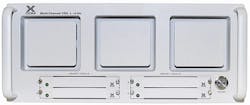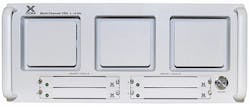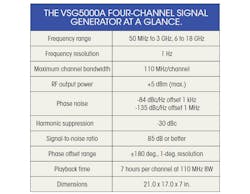Modern signals can be complex, taxing the capabilities of even the best test sources. Fortunately, the model VSG5000A phase-coherent vector signal generator from X-COM Systems is actually four independent sources capable of tuning from 50 MHz to 3 GHz and 6 to 18 GHz with 1-Hz frequency resolution. It provides enough parameter control to recreate the various combinations of frequency, amplitude, and phase found in radar, communications, and other high-frequency systems through 18 GHz—whether multiple signals are independent or synchronized. It measures only 21 x 17 x 7 in., weighs 60 lbs, and mounts in a 4U rack space.
The VSG5000A phase-coherent vector signal generator (see figure) can create any number of different complex signal environments, using pulsed or continuous waveforms. It can start with waveform sequences that were captured by X-COM’s IQC5000A RF record and playback system, and then uploaded to the VSG5000A; those captured by another system; or even those created with software such as MATLAB from The MathWorks. It can accept files in a wide range of formats, including .xiq, .tiq, .dat, bin, .txt, and .mat.
The VSG5000A combines four independent RF signal generators with solid-state waveform storage, in a 4U rack-mount enclosure.
Signals from the VSG5000A’s four channels can be phase aligned or skewed, with phase control in increments as small as 1 deg. Each channel provides 110-MHz bandwidth (see table) for a four-channel signal bandwidth total of 440 MHz to simulate many radar signals. For more complex environments, multiple units can be synchronized to produce as many as 32 channels with an aggregate bandwidth of 32 x 110 MHz or 3500 MHz. The VSG5000A includes enough memory to store 50 minutes of signal information per channel at a 110-MHz bandwidth, and more than 13 hours of storage per channel at a 10-MHz bandwidth.
Each channel uses a separate data-storage module, removable from the front panel and expandable to as much as 7 hours of storage per channel at a 110-MHz bandwidth (4.5 days at a 10-MHz bandwidth). Waveforms are stored in a 16-b in-phase (I) and quadrature (Q) format with data offload accomplished in Serial Attached SCSI (SAS) format.
Each VSG5000A employs a single low-noise frequency reference to ensure phase coherency among the four channels. It can also work with a precision 10-MHz external clock oscillator when it is necessary to synchronize the VSG5000A with other equipment as part of a larger automated system. For example, when the VSG5000A is combined with an external vector signal generator for each channel, signals at any center frequency from kilohertz to millimeter wavelengths can be seamlessly combined to create sequences of any length and complexity. An external timing module is available that allows phase alignment of as many as eight VSG5000As.
A VSG5000A four-channel signal generator provides output signals at levels to +5 dBm, with a built-in attenuation range of 0 to 25 dB for level control. The generator includes a Gigabit Ethernet communications port; it is rated for operating temperatures from +10 to +40°C and altitudes to 15,000 ft. The power requirements are 470 W at 120/240 VAC.
X-COM Systems, 12345B Sunrise Valley Dr., Reston, VA 20191, (703) 390-1087.
About the Author
Jack Browne
Technical Contributor
Jack Browne, Technical Contributor, has worked in technical publishing for over 30 years. He managed the content and production of three technical journals while at the American Institute of Physics, including Medical Physics and the Journal of Vacuum Science & Technology. He has been a Publisher and Editor for Penton Media, started the firm’s Wireless Symposium & Exhibition trade show in 1993, and currently serves as Technical Contributor for that company's Microwaves & RF magazine. Browne, who holds a BS in Mathematics from City College of New York and BA degrees in English and Philosophy from Fordham University, is a member of the IEEE.


